|
Shotgun Gauge and Ammunition
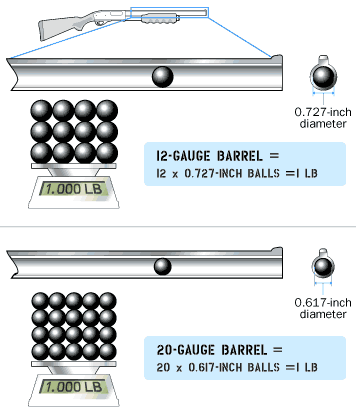 The
caliber of a shot gun is called gauge and is based on a time when lead
was sold by the pound. The gauge was the number of lead balls that could
be made equal to the diameter of the shot gun barrel from one pound of
lead. So the higher the number the smaller the shot gun barrel.
The
caliber of a shot gun is called gauge and is based on a time when lead
was sold by the pound. The gauge was the number of lead balls that could
be made equal to the diameter of the shot gun barrel from one pound of
lead. So the higher the number the smaller the shot gun barrel.
Shot guns are commonly available in a variety of sizes from
the 10-gauge (largest) to the .410 (smallest and only shot gun size not based on gauge). The
most popular are 12-gauge - which is more powerful and typically used
for large game and self defense - and 20-gauge - which is less powerful
and typically used for small game and skeet. If shot guns were measured
in caliber, the 12-gauge would be a .727 - nearly 3/4-inch diameter.
(Graphic from
How Stuff Works
).
Shot guns offer something that most rifles and hand guns do
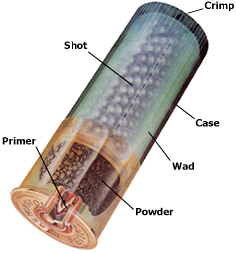 not
- a wider variety of ammunition for a wider variety of purposes, all
fired from the same gun. A shot gun cartridge is similar in construction
to rifle and hand gun cartridge. It has a casing, primer, powder,
projectile, plus a wad (made of plastic or dense fabric) between the
gunpowder and the projectile. The projectile can be either a slug or
pellets (also called shot). The purpose of the wad is to prevent the gas
from gun powder exploding from blowing by the projectile. A slug is
the same size diameter as the shot gun barrel, just like the bullet is
the same size as the rifle or hand gun barrel. Shot is many smaller
diameter pellets.
not
- a wider variety of ammunition for a wider variety of purposes, all
fired from the same gun. A shot gun cartridge is similar in construction
to rifle and hand gun cartridge. It has a casing, primer, powder,
projectile, plus a wad (made of plastic or dense fabric) between the
gunpowder and the projectile. The projectile can be either a slug or
pellets (also called shot). The purpose of the wad is to prevent the gas
from gun powder exploding from blowing by the projectile. A slug is
the same size diameter as the shot gun barrel, just like the bullet is
the same size as the rifle or hand gun barrel. Shot is many smaller
diameter pellets.
|
|
|
Shot can be various sizes. Larger shot (such as buck shot for deer) is for larger game and smaller shot is for smaller game (such as game shot for fowl). Naturally, the larger the shot size, the less number of pellets per cartridge - nine per cartridge of 00 buck shot and 27 per cartridge of 7-1/2 game shot. Here's a few examples.
Click pictures to enlarge.
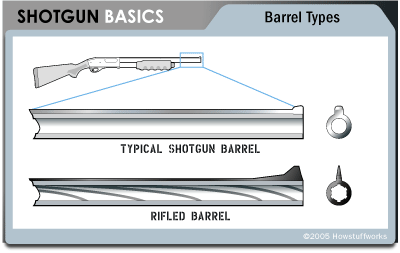 Rifles and hand guns have groves in the barrel (called rifling) which make bullets spin when fired. Shot guns barrels typically have no groves and are called smooth bore. Given that the pellets are all individual projectiles, the smooth bore provides less disturbance to their travel through the barrel. Some have rifling and as they are designed to fire only slugs. (Graphic from
How Stuff Works
.)
Rifles and hand guns have groves in the barrel (called rifling) which make bullets spin when fired. Shot guns barrels typically have no groves and are called smooth bore. Given that the pellets are all individual projectiles, the smooth bore provides less disturbance to their travel through the barrel. Some have rifling and as they are designed to fire only slugs. (Graphic from
How Stuff Works
.)
Firing multiple pellets per round increases the odds of hitting a target over firing just one bullet per round, even from less than ideal conditions. This is why the shot gun was the preferred gun of choice in the old west for security detail on stagecoaches. (Where did you think "riding shot gun" came from?)
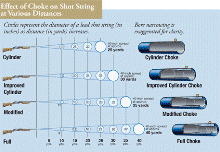 The spread of shot guns can also be modified by use of chokes. A choke is constriction at the end of the shotgun barrel that controls the spread of the pellets shot, like the nozzle of a garden hose. There are four types of choke:
The spread of shot guns can also be modified by use of chokes. A choke is constriction at the end of the shotgun barrel that controls the spread of the pellets shot, like the nozzle of a garden hose. There are four types of choke:
Full choke - tightest pattern
Modified - second tightest pattern
Improved - second widest pattern
Open choke (or open bore) -widest pattern
Click to enlarge.
(From
Today's Hunter
.)
With all of the various options for shot guns, it is very important to always check the size of the barrel and the cartridge. Using the wrong cartridge (such as 20-gauge cartridge in a 12-gauge shotgun) can result in a blockage in the barrel which can cause the barrel to explode in the shooter's hands on the next round. The barrel size is stamped into the side of the barrel and the cartridge size is printed on the side and stamped into the head of the cartridge.

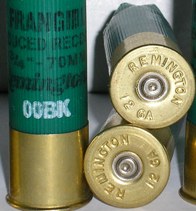
|


 The
caliber of a shot gun is called gauge and is based on a time when lead
was sold by the pound. The gauge was the number of lead balls that could
be made equal to the diameter of the shot gun barrel from one pound of
lead. So the higher the number the smaller the shot gun barrel.
The
caliber of a shot gun is called gauge and is based on a time when lead
was sold by the pound. The gauge was the number of lead balls that could
be made equal to the diameter of the shot gun barrel from one pound of
lead. So the higher the number the smaller the shot gun barrel.
 not
- a wider variety of ammunition for a wider variety of purposes, all
fired from the same gun. A shot gun cartridge is similar in construction
to rifle and hand gun cartridge. It has a casing, primer, powder,
projectile, plus a wad (made of plastic or dense fabric) between the
gunpowder and the projectile. The projectile can be either a slug or
pellets (also called shot). The purpose of the wad is to prevent the gas
from gun powder exploding from blowing by the projectile. A slug is
the same size diameter as the shot gun barrel, just like the bullet is
the same size as the rifle or hand gun barrel. Shot is many smaller
diameter pellets.
not
- a wider variety of ammunition for a wider variety of purposes, all
fired from the same gun. A shot gun cartridge is similar in construction
to rifle and hand gun cartridge. It has a casing, primer, powder,
projectile, plus a wad (made of plastic or dense fabric) between the
gunpowder and the projectile. The projectile can be either a slug or
pellets (also called shot). The purpose of the wad is to prevent the gas
from gun powder exploding from blowing by the projectile. A slug is
the same size diameter as the shot gun barrel, just like the bullet is
the same size as the rifle or hand gun barrel. Shot is many smaller
diameter pellets.
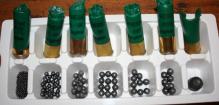


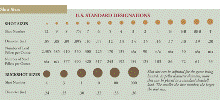
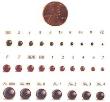
 Rifles and hand guns have groves in the barrel (called rifling) which make bullets spin when fired. Shot guns barrels typically have no groves and are called smooth bore. Given that the pellets are all individual projectiles, the smooth bore provides less disturbance to their travel through the barrel. Some have rifling and as they are designed to fire only slugs. (Graphic from
Rifles and hand guns have groves in the barrel (called rifling) which make bullets spin when fired. Shot guns barrels typically have no groves and are called smooth bore. Given that the pellets are all individual projectiles, the smooth bore provides less disturbance to their travel through the barrel. Some have rifling and as they are designed to fire only slugs. (Graphic from



